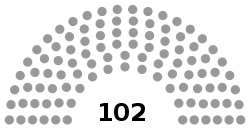House of Elders (Afghanistan)
The House of Elders or Mesherano Jirga (Pashto/Dari: مشرانو جرگه یا خانه کهن سالان), is the upper house of the bicameral National Assembly of Afghanistan, alongside the lower House of the People (Wolesi Jirga). The House of Elders primarily has an advisory role rather than a maker of law. However, it does have some veto power.
House of Elders مشرانو جرگه یا خانه کهن سالان | |
|---|---|
| Type | |
| Type | |
| History | |
| Founded | 1931[1] |
| Leadership | |
Speaker | Fazel Hadi Muslimyar since 29 January 2011 |
First Deputy Speaker | Mohammad Alam Izedyar since 29 January 2011 |
Second Deputy Speaker | Mohammad Asif Sediqi since 29 January 2011 |
| Structure | |
| Seats | 102 members |
 | |
Political groups |
|
| Authority | advisory and limited veto power; no law-making power |
| Elections | |
| One-third by district councils, One-third by provincial councils, One third nominated by the president | |
| Meeting place | |
| Kabul | |
| Website | |
| mj | |
 |
|---|
| This article is part of a series on the politics and government of Afghanistan |
|
Government Executive
Legislature
Judiciary |
|
Administrative divisions
|
|
|
The House of Elders has 102 members. One-third (34) are elected by district councils (one per province) for three-year terms, one-third (34) by provincial councils (one per province) for four-year terms, and one-third (34) are nominated by the president for five-year terms. However, elections for the district councils were not held in the 2005 parliamentary elections. As such, each provincial council also selected one of its elected members to temporarily hold seats in the house until district council elections are held. Half of the presidential nominees have to be women, two representatives from the disabled and impaired and two from the Kuchis.[2]
Speakers
Speakers of the Mesherano Jirga since establishment in 1931
| Name | Entered office | Left office | Notes |
|---|---|---|---|
| Mirza Abdul Latif Khan | 1931 | 1933 | [1] |
| Mohammed Ata Khan | 1934 | 1936 | [1] |
| Mir Ata Mohammad Khan | 1937 | 1939 | [1] |
| Mir Ata Mohammad Khan | 1940 | 1942 | [1] |
| Mir Ata Mohammad Khan | 1943 | 1945 | [1] |
| Fazi Ahmad Khan Mojadadi | 1946 | 1948 | [1] |
| Fazi Ahmad Khan Mojadadi | 1949 | 1951 | [1] |
| Fazi Ahmad Khan Mojadadi | 1952 | 1954 | [1] |
| Fazi Ahmad Khan Mojadadi | 1955 | 1957 | [1] |
| Hafiz Abdul Ghafar | 1958 | 1960 | [1] |
| Abdul Hadi Dawi | 1961 | 1964 | [1] |
| Abdul Hadi Dawi | 1965 | 1968 | [1] |
| Abdul Hadi Dawi | 1969 | 1972 | [1] |
| Dissolved | 1973 | 1988 | |
| Mahmood Habibi | 31 May 1988 | 1992 | [3][4] |
| Not functioning | 1992 | 2005 | |
| Sibghatullah Mojaddedi | December 2005 | 29 January 2011 | [5] |
| Fazel Hadi Muslimyar | 29 January 2011 | Incumbent | [5] |
Reserved seats for women
Having been absent from the decision-making process for centuries, Afghan women for the first time entered the political arena in 2001, after the overthrow of Taliban. With the introduction of reserved seats provision in the 2002 Emergency Loya Jirga, when ten percent of 1600 seats were reserved for women, the ground was laid for participation of Afghan women in parliament.
The new 2004 constitution secured reserved seats for women and minorities in both houses of parliament. In the 2005 parliamentarian elections, Afghan women won 89 seats. According to the Inter-Parliamentary Union, in 2009 they held 67 seats (27.7%) in the House of the People and 22 (21.6%) in the House of Elders. This representation is above the worldwide average of 18.5% and above the average of the United States at 16.8% for the House and 15.4% for the Senate.
See also
- National Assembly of Afghanistan
- House of the People (Afghanistan)
- Politics of Afghanistan
- List of legislatures by country
References
- "A glance of the History of Assemblies of Afghanistan" (PDF). Wolesi Yirga. 25 January 2019.
- Article 84 of the Afghan Constitution.
- "Central Asia". Area Study Centre (Central Asia), University of Peshawar. 19 February 1996 – via Google Books.
- https://crossasia-journals.ub.uni-heidelberg.de/index.php/iaf/article/download/105/100
- http://mj.parliament.af/